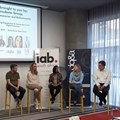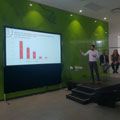
Unlock integrated attribution complexity in digital marketing

There’s no denying that the current trajectory of digital marketing will grow in impetus as more technological changes result in better-integrated marketing opportunities, but the attribution challenge is real, especially when you factor in long lead cycles and multiple touchpoints from a single customer.
Simply put, it’s a “longstanding quest to figure out which touchpoints are truly moving the needle,” in determining exactly which campaigns resulted in sales and how the various related marketing efforts influenced those purchase decisions.
As a result, the IAB’s morning session will cover a 360-view of digital’s role across publisher, agency, and brand, with Singh also presenting on how digital access for all will impact the digital marketing landscape. Singh explains:
From a commercial perspective, increased access to the internet means an increased consumer base. The more people who are able to get online – and who have the relevant skills to use the internet meaningfully once they are online – will broaden the number of people participating in the digital economy. In seeking to bridge the various digital divides, such as the urban/rural divide in internet access, this has the potential to open up new markets that may have previously been untapped.If more consumers are able to get online, the benefits in respect of digital marketing become readily apparent: consumers are able to stay current and up-to-date on new products and service offerings; it is convenient and not bound by physical location; and consumers can access relevant information around the clock, at their own leisure.
However, there is also a broader public interest consideration that is relevant. If we share a common vision for a more equal and just society – in which all persons have access to equal opportunities – then access to the internet must further be recognised as a crucial enabler for the full array of fundamental rights, to ensure that all persons are able to participate equally in the socio-economic opportunities that the country has to offer.
Talk us through the context of integrated attribution and what this means for today’s marketer.
Naidoo: Integrated attribution is a holy grail for marketers. If we adopt a South African lens, a handful of brands are actually getting integrated attribution right.
The reason for this is simply that brands have been looking at attribution from a channel perspective and lost sight of the consumer. The consumer journey or path to purchase have evolved and no longer confined to a single channel or device.The foundation of building a robust integrated attribution model can be centred on three pillars: technology, a strong measurement framework and the transparency of data. We need to focus on the science of marketing in order to contribute to revenue growth in the future.
Many brands are still in the nascent stage trying to figure this out. There are contributing factors that provide context to the current state of attribution:
• Marketers are passively reviewing post-campaign reports to make future decisions on campaigns often using vanity metrics like clicks, engagement and views.
• Media buying is fragmented and consolidation is required from both an Adtech and Martech perspective. Both need to be inter-connected.
• Transparency in the media value chain unlocking data and promoting visibility in the customer journey. Walled gardens are resistant to sharing data.
• Consumers have access to multiples devices and shift across channels making it more difficult to measure true attribution. (Consumer journey is not linear). Customers are channel-agnostic.
• Naming taxonomies are inconsistent leading to errors and non-identifiers of channel and message effectiveness.
• A shift needs to happen from the marketing of campaigns to an always-on approach hence making data-led decisions and a shift towards continuous optimisation.
• Marketers lack the correct skillset, tools, processes to produce meaningful analysis.
• Integrated attribution is a journey, not a destination.
Nicholson: I would personally define integrated attribution as the study of all marketing tactics that are contributing to sales conversions.
For many marketers raised in the digital era, the idea of attribution seems to be more firmly attached to the bottom of the marketing funnel metrics and this has become something of an obsession.
This trend was driven by search and came to the fore with the advent of Adwords. When thinking about last-click attribution, for instance, we can’t blame Google for citing a metric in which they scored particularly well.
I would argue that it has caused a skewed understanding when it comes to analysing attribution metrics. In black and white, search attribution numbers look incredible, so there is a tendency to cut back on display and video when they don’t produce the same sort on numbers.
The challenge is that marketers adopting this approach will find their search numbers dipping soon enough. If you turn the taps off at the top, your conversions at the bottom will dry up, of this I am certain.
That’s for sure. What conversations are you having with your clients around last-click attribution and the role publishers play in the conversion funnel?
Nicholson: So many of our client conversations these days revolve around attribution. While clients are challenging us to produce qualified leads that they can convert, we are challenging them to place more value on the top- and mid-funnel interactions within our environment.
We want our clients to understand that metrics like brand lift and engagement are equally valuable and will ultimately lead to better attribution.
OK, let’s rewind a bit: Explain how digital’s role in the marketing mix has shifted over the years.
Naidoo Digital has disrupted the marketing mix over the past decade due to the rapid advancement in tech, AI, ML and consumer behaviour on digital channels and devices.
The traditional 4Ps are now the 7Ps - sometimes even 12Ps. The reason for the many iterations is due to the constant changes happening in the digital world. We have moved from adopting a passive view of the marketing mix into a more agile, ever-changing view of how we apply it into our marketing efforts.If I were to focus on the direct impact digital has had on the marketing mix, I would focus on the following contemporary version of the Ps:
- Product – products are co-created between brands and consumers. For example, Lego encourages ideas and designs from their fans on their online platforms. Fans can then vote on the best creations and the creator earns a percentage of the sales, completely disrupting the legacy way of developing products. This concept celebrates loyal customers and rewards them for innovation, creativity and entrepreneurialism.
- Process – Automation, systems and processes now play a critical role in the marketing mix. E-commerce entities like Amazon and Walmart can attribute their successes to their processes.
- Promotion – Included in promotion would be permission-based marketing, personalisation and partnerships.
Marketers need to keep themselves abreast of the evolving changes of the marketing mix in order to deliver more effective marketing strategies and business outcomes.
Nicholson: It’s interesting to note how digital has shifted to a very performance marketing-focused cycle lately, obviously due to the relative trackability of digital media vs other channels.
But, without any brand saliency or awareness being created in the channel, the top of the funnel is being left unattended. This leaves the performance of campaigns scrambling to get as much relevant inventory and audience created out of basically 'thin air'.
To bring it back to our own environment, we are often tasked with providing a solution that will be measured on a conversion metric. However, the brands concerned spend no top- or mid-funnel budget within our environment.
Moving forward, I would love to see the market place an appropriate value on digital channels' ability to drive activity at the top and middle of the funnel.
Our own mobile brand lift study conclusively proved that digital media is very effective at driving awareness, consideration and preference. Get those metrics right and conversion will follow.
Love that. Switching focus to the publisher side then, please share an insight or learning you’ve gained by reviewing a campaign with regard to attributing performance or lack of performance within the campaign.
Nicholson: I can think of several instances where we have worked with the client to drive attribution. This is only possible when working with a client who is open-minded about sharing their own data insights with us whether that be anecdotally, or preferably, giving us the ability to tag their own sites.
We have seen clear evidence with campaigns for some of our financial clients, for whom lead generation is a very important metric.
When top-of-funnel activity was dropped or slowed down in our environment, within a week the knock-on effect was evident in our client’s numbers across the board, including last-click attribution efforts, which were focused on search.
What further changes do you predict we will see in this regard as we approach 2020?
Naidoo:
- Consolidation of tech stacks – brands are re-defining their martech/adtech strategies.
- Data privacy to play a more vital role for marketers.
Nicholson: Cross-platform attribution would be phenomenal, if it were implementable and ran seamlessly.
Practically, this implementation is very difficult. Particularly mobile apps, Facebook, Twitter, search, Chrome and other browsers are decidedly difficult to track in one place. So, when it comes to an attribution of which environment or campaign was the performer, it’s not so evident right away without testing and trialling.
My prediction is that media owners and brands will build closer relationships, built around trust and data to drive performance of their advertising spend.
Excellent. Let’s end with some helpful tips to help SA marketers make better digital decisions.
Naidoo:
1. Start with defining a measurement framework for your business that considers media, analytics and business metrics.
2. Attribution efforts should be a consistent effort. Start small and measure what you can.
3. Audit your current tech stack and define a strategy that’s closely aligned to your business goals.
Nicholson:
1. Learn about attribution – really learn it, and understand that display and video are so important to the bottom-line of not just ROI, but ROAS – Return on Advertising Spend. You will convert better if you build salience and preference in the same channel you seek to convert from.
2. Focus on making your own platforms a better customer experience.
Ultimately, media partners can lead a horse to water, but we can’t make it drink. Much of what it takes to convert a customer is on the brand owner in the final phase.
3. If we all accept that mobile is no longer a trend but the reality of digital media, then marketers need to double down on their development of mobile-friendly assets. Many marketers are retaining desktop in the mix because they claim that it works better in the conversion phase. Truthfully, we believe this is because conversion assets are just not designed optimally for mobile formats. If you’re still asking for more detail than a name and email address in the mobile environment to generate leads, you won’t generate any.
Excellent insights to help you thrive in the digital economy. Watch for my separate interview with sponsor Mediamark and stay tuned for more from the IAB Insight Series, which comes back to Cape Town on 28 November for The Business of Digital Influencer Marketing. Standard tickets cost R500, free for IAB members. Email ten.asbai@aluaP for sponsorship opportunities and keep an eye on the IAB SA website or visit Facebook and Twitter for further updates! You can also subscribe to the IAB Insight Series emailers and don’t miss the IAB Youtube Insight Series.
About Leigh Andrews
View my profile and articles...













